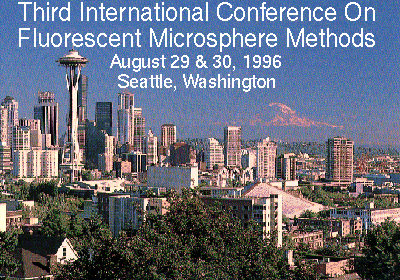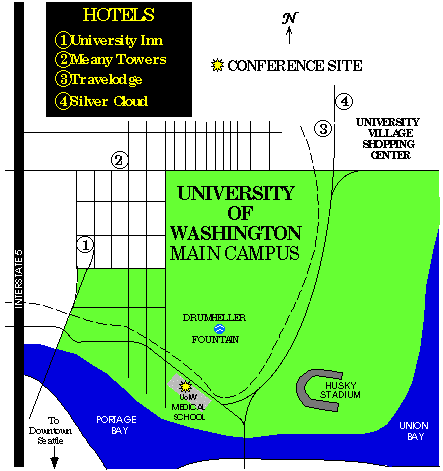

| When: | Thursday and Friday, August 29 and 30, 1996 |
| Where: | University of Washington Medical Center School of Medicine Seattle, Washington |
 Click to view a collage of University of Washington pictures.
Click to view a collage of University of Washington pictures.Maps will be provided with registration.
![]()
Purpose - The use of fluorescent microspheres for measuring regional organ
blood flow has recently been introduced [Journal of Applied Physiology
74:2585-2597, 1993]. As current methodologies evolve, the full potential of this
new tool can be best realized through a community effort in which scientists
freely exchange ideas. The purpose of this conference is to foster further
development of fluorescent microspheres by disseminating information and
facilitating communication between scientists. Two new applications of
fluorescent microspheres will be introduced at the conference; histologic methods
for assessing blood flow distribution at the microcirculatory level and the use
of aerosolized fluorescent microspheres for measuring regional lung ventilation.
Structure - Presentations at the conference will include
general topics as well as original scientific research.
Call for abstracts - Any original scientific research dealing with the use of
microspheres for estimating regional organ perfusion or ventilation is welcome.
All abstracts will be accepted for presentation. Abstracts will be designated
for either oral or poster presentations by a selection committee.
Abstracts must be submitted in both typed and electronic form. Abstract forms
will be mailed upon request. Electronic versions of the abstracts can be
submitted by disk (either Mac or IBM) or by anonymous ftp to: fmrc.pulmcc.washington.edu.
Any word processing format is acceptable. The deadline for abstract submission
is Tuesday July 2, 1996. Abstract deadline extended.
Abstracts will be published electronically on the FMRC Web server where they can
be searched and retrieved. Circulation journals are being asked to consider
publishing these abstracts.
![]()
The content of the scientific research presented will be determined by the
submitted abstracts and will include both oral and poster presentations. The
curriculum should appeal to scientists who are just beginning to consider using
fluorescent microspheres as well as those who have original science to share.![]()
![]()
| Before April 30, 1996 | |
|
|
$230.00 $200.00 $200.00 |
| After April 30, 1996 | |
|
|
$270.00 $240.00 $240.00 |
Registration forms will be mailed upon request.
Address for abstract and registration forms:
or email: fmrc@pele.pulmcc.washington.edu
![]()
| Social Event Fees | |
|
|
Free $50.00 |
![]()
Local Hotels - The following hotels have agreed to provide rooms at a
discounted price for those attending the conference. Rooms cannot be guaranteed
at the discounted price less than 30 days prior to the conference. You must mention the
Fluorescent Microsphere Group (FMS Room Block) when making your reservation(s) in order to
receive the discounted rates. All hotels
are located within walking distance of the University of Washington and the
conference except those indicated by an asterisk (*). The hotels marked with an
asterisk are more convenient to the center of Seattle. A
map indicating the location of the hotels will be included with the registration
materials.
Meany Towers
Silver Cloud
Travel Lodge
The University Inn
Sheraton(*)
Stouffer-Madison-Renaissance(*)
Visiting the FMRC - Conference attendees are welcome to visit the Fluorescent
Microsphere Resource Center. Because of the busy schedule during the conference,
we encourage those interested to visit a few days before or after the conference.
Staff in the FMRC will be available to answer questions and demonstrate
fluorescent microsphere methods.
Visiting the University of Washington and the Medical Center - Conference
attendees may wish to tour the University and/or the Medical Center. Personal
arrangements can be made to visit with faculty and their laboratories.
 For those wishing a different accomodation experience here are
some Bed & Breakfast Inns of Seattle
For those wishing a different accomodation experience here are
some Bed & Breakfast Inns of SeattleSeattle & Pacific Northwest Attractions
These sites include information on restaurants, outdoor attractions,
entertainment, shopping information and much, much more.
![]() Revised: May 31, 1996
Revised: May 31, 1996